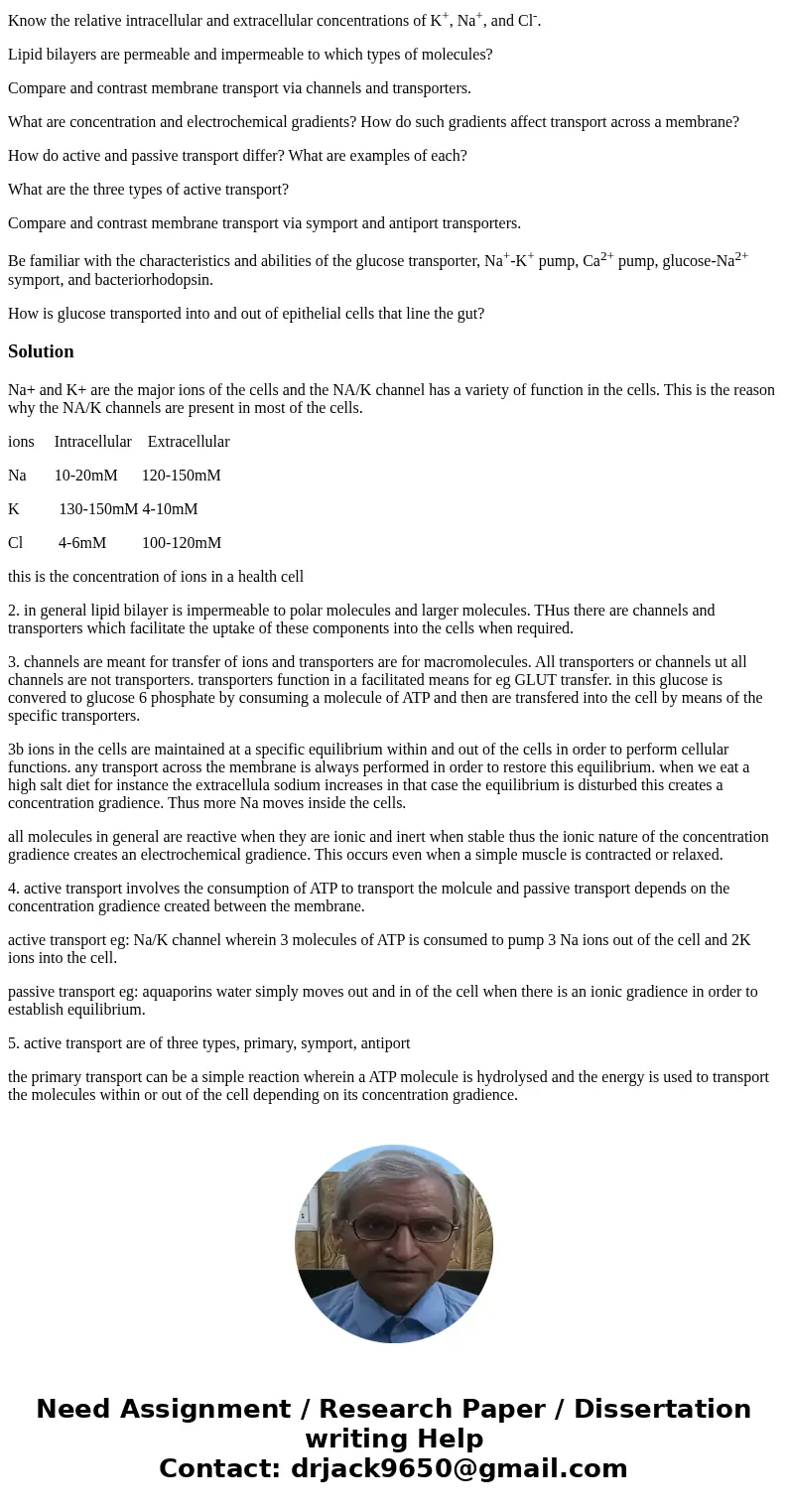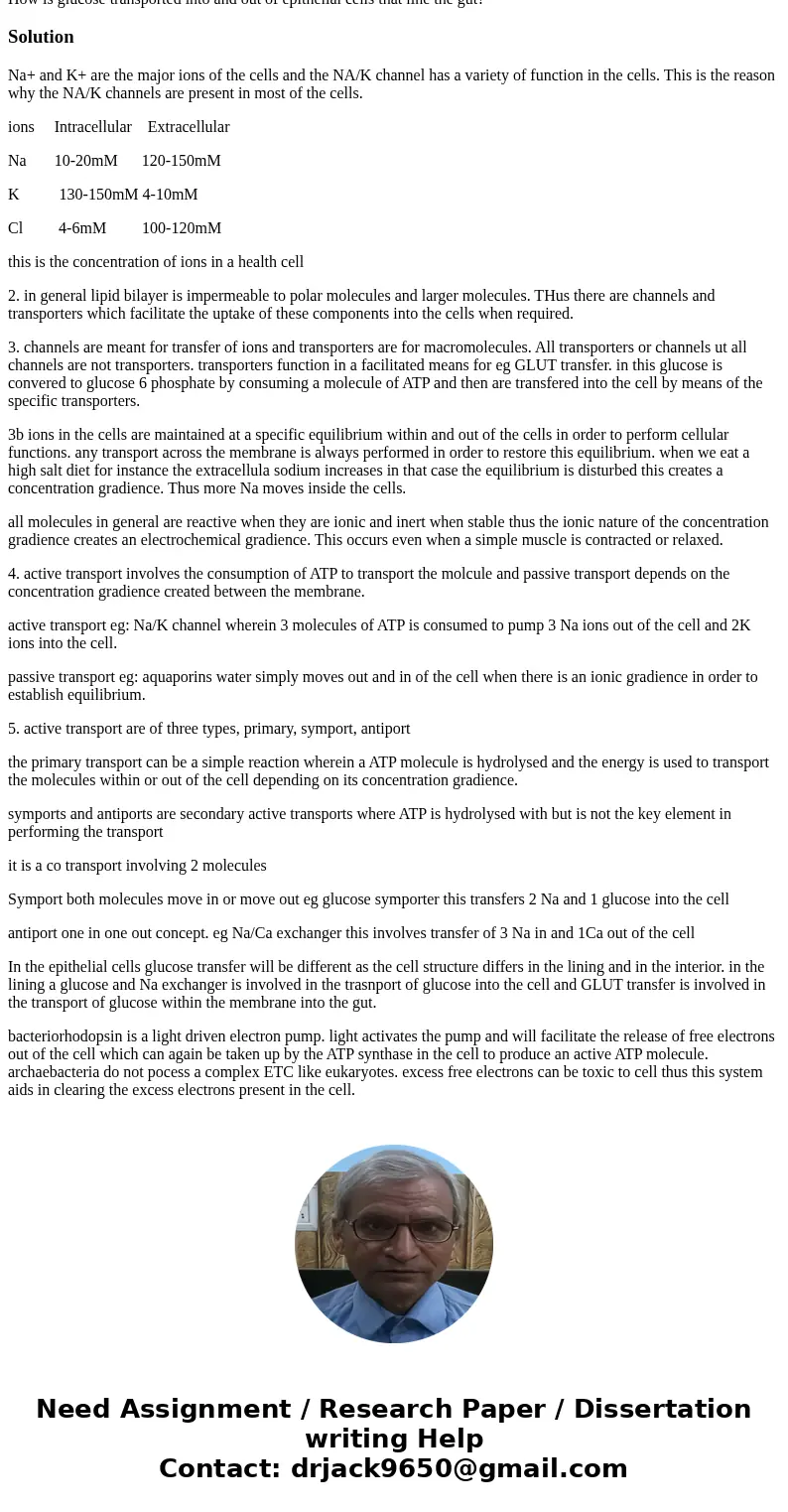Know the relative intracellular and extracellular concentrat
Know the relative intracellular and extracellular concentrations of K+, Na+, and Cl-.
Lipid bilayers are permeable and impermeable to which types of molecules?
Compare and contrast membrane transport via channels and transporters.
What are concentration and electrochemical gradients? How do such gradients affect transport across a membrane?
How do active and passive transport differ? What are examples of each?
What are the three types of active transport?
Compare and contrast membrane transport via symport and antiport transporters.
Be familiar with the characteristics and abilities of the glucose transporter, Na+-K+ pump, Ca2+ pump, glucose-Na2+ symport, and bacteriorhodopsin.
How is glucose transported into and out of epithelial cells that line the gut?
Solution
Na+ and K+ are the major ions of the cells and the NA/K channel has a variety of function in the cells. This is the reason why the NA/K channels are present in most of the cells.
ions Intracellular Extracellular
Na 10-20mM 120-150mM
K 130-150mM 4-10mM
Cl 4-6mM 100-120mM
this is the concentration of ions in a health cell
2. in general lipid bilayer is impermeable to polar molecules and larger molecules. THus there are channels and transporters which facilitate the uptake of these components into the cells when required.
3. channels are meant for transfer of ions and transporters are for macromolecules. All transporters or channels ut all channels are not transporters. transporters function in a facilitated means for eg GLUT transfer. in this glucose is convered to glucose 6 phosphate by consuming a molecule of ATP and then are transfered into the cell by means of the specific transporters.
3b ions in the cells are maintained at a specific equilibrium within and out of the cells in order to perform cellular functions. any transport across the membrane is always performed in order to restore this equilibrium. when we eat a high salt diet for instance the extracellula sodium increases in that case the equilibrium is disturbed this creates a concentration gradience. Thus more Na moves inside the cells.
all molecules in general are reactive when they are ionic and inert when stable thus the ionic nature of the concentration gradience creates an electrochemical gradience. This occurs even when a simple muscle is contracted or relaxed.
4. active transport involves the consumption of ATP to transport the molcule and passive transport depends on the concentration gradience created between the membrane.
active transport eg: Na/K channel wherein 3 molecules of ATP is consumed to pump 3 Na ions out of the cell and 2K ions into the cell.
passive transport eg: aquaporins water simply moves out and in of the cell when there is an ionic gradience in order to establish equilibrium.
5. active transport are of three types, primary, symport, antiport
the primary transport can be a simple reaction wherein a ATP molecule is hydrolysed and the energy is used to transport the molecules within or out of the cell depending on its concentration gradience.
symports and antiports are secondary active transports where ATP is hydrolysed with but is not the key element in performing the transport
it is a co transport involving 2 molecules
Symport both molecules move in or move out eg glucose symporter this transfers 2 Na and 1 glucose into the cell
antiport one in one out concept. eg Na/Ca exchanger this involves transfer of 3 Na in and 1Ca out of the cell
In the epithelial cells glucose transfer will be different as the cell structure differs in the lining and in the interior. in the lining a glucose and Na exchanger is involved in the trasnport of glucose into the cell and GLUT transfer is involved in the transport of glucose within the membrane into the gut.
bacteriorhodopsin is a light driven electron pump. light activates the pump and will facilitate the release of free electrons out of the cell which can again be taken up by the ATP synthase in the cell to produce an active ATP molecule. archaebacteria do not pocess a complex ETC like eukaryotes. excess free electrons can be toxic to cell thus this system aids in clearing the excess electrons present in the cell.


 Homework Sourse
Homework Sourse